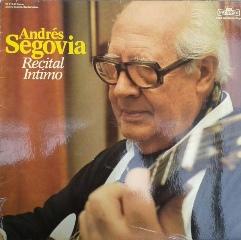Andres Segovia - Recital Intimo (1975)
Andres Segovia - Recital Intimo (1975)

1 S.L. Weiss-Bourrée 3:25 2 G. Benda-Sonatina In D-Dur 2:25 3 G. Benda-Sonatina In D-Moll 3:10 4 J.S. Bach-Prélude Aus Der Suite Nr. 1 G-Dur Für Violoncello 2:38 5 J.S. Bach-Sarabande 2:48 6 J.S. Bach-Menuett I&II 4:10 7 D. Scarlatti-Larghetto 2:55 8 D. Scarlatti-Menuett 1:30 9 F. Sor-Andante In C-Moll & Menuett In C-Dur 7:00 10 F. Sor-Menuett In A-Dur 2:26 11 F. Sor-Menuett In C-Dur 3:14 12 V. Asencio-Dipso Andrés Segovia – guitar
The father of the modern classical guitar movement, Andres Segovia raised his chosen instrument to new peaks of popularity and respectability; it is widely held that without his efforts, the classical guitar would still remain in the eyes of purists a lowly bar instrument, to be performed only by peasants. Born in Linares, Spain on February 21, 1893, Segovia began playing at the early age of four; although discouraged by his family, who felt he should adopt a "real" instrument instead, he continued studying and made his concert debut in Granada at the age of 16. His professional debut came four years later in Madrid, and was met by many with disbelief — the guitar was widely believed to be incapable of proper classical expression, but Segovia astounded naysayers with his skill. The central problem facing him, however, remained that the guitar's sound could not properly fill a concert hall; in the years to follow, Segovia solved the dilemma by experimenting with new woods and designs, all to increase the instrument's natural amplification. The advent of nylon strings also enabled the guitar to produce more consistent tones, while projecting the sound much farther. In 1928, Segovia made his American debut in New York City, where he again wowed audiences with his prowess; before long, composers like Heitor Villa-Lobos even began to compose original pieces specifically for the guitar. Segovia himself began transposing the classical canon for the guitar as well, most notably his notoriously difficult translation of Bach's Chaconne, as well as many transcriptions of lute and harpsichord music. In addition to recording and performing, Segovia spent the remainder of his life and career successfully influencing the authorities at conservatories, academies, and universities to include the guitar in their instruction programs with the same emphasis given the violin, cello and piano; his early struggles were recounted in his 1983 memoir Andres Segovia: An Autobiography of the Years 1893-1920. He died in 1987. --- itunes.apple.com
download (mp3 @224 kbs):
uploaded yandex 4shared mega mediafire zalivalka cloudmailru oboom uplea








